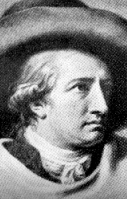

Most people know the basic premise: professor Faust is bored with life and yet does not want to die; he wants to know more, to know everything, to have power. And so he sells his soul to Mephistopheles (i.e., the devil), who pledges servitude to Faust until the latter dies. Mephistopheles plans to take Faust on a wild ride, as he details in this aside:
Go on despising reason and learning, man’s greatest asset. Let me entangle you in my deceits and magic shows and I’ll get you for sure. This man was born with a spirit that drives him on incessantly and will not be curbed. All at such a pace that he overleaps the common pleasures. I’ll drag him through a round of riotous living, where everything is shallow and meaningless, till I have him at my mercy like a fly on a fly-paper. I’ll dangle food and drink before his greedy mouth. He’ll beg in vain for refreshment. He’d be sure to go under anyway, even if he hadn’t given himself to the devil.Johann Wolfgang von Goethe's FAUST In Music
Johann Wolfgang von Goethe, born on 28 August 1749 in Frankfurt, Germany; his father the Imperial Councillor Johann Kaspar Goethe (1710-1782) and his mother Katharina Elisabeth neé Textor (1731-1808). German poet, playwright, novelist, and natural philosopher is best known for his two-part poetic drama Faust, (1808-1832) which he started around the age of twenty three and didn't finish till shortly before his death sixty years later. He is considered one of the greatest contributors of the German Romantic period. Goethe's early years of education were inconsistent; informally from his father and then with tutors. However, he managed a grasp of Greek, Latin, French, and Italian by the age of eight, and his mother taught him well in the art of story-telling. At the age of sixteen, in 1765, Goethe went to Leipzig University to study law as his father wished, though he also gained much recognition from the Rococo poems and lyric he wrote during this period. In 1766 he fell in love with Anne Catharina Schoenkopf (1746-1810) and wrote his joyfully exuberant collection of poems Annette.
Written between 1844 and 1853, Scenes from Goethe's Faust (Szenen aus Goethes Faust) has been described as the height of composer Robert Schumann's accomplishments in the realm of dramatic music.[1] This oratorio was written for SATB chorus, boy's chorus, orchestra, and a number of solo parts which, even with doubling, require seven solo singers, although eight (three sopranos, two mezzos, one tenor, one baritone, and one bass) is the usual number for a performance.
Schumann's work on what he labeled an oratorio began in 1842. This was just over a decade after the death of Johann Wolfgang von Goethe, who completed Part Two of the dramatic poem Faust in his final year.[2] Many contemporary readers of Faust found Goethe's epic poem daunting and difficult to grasp. Goethe himself declared only Mozart fit to write the music for it (though Mozart died in 1791, almost 20 years prior to the completion of Part One of Faust).
>> http://www.imagi-nation.com/moonstruck/clsc20.html >> http://www.online-literature.com/goethe/AND,
 Francisco de Goya (1746–1828) and the Spanish Enlightenment
Francisco de Goya (1746–1828) and the Spanish Enlightenmenthttp://www.metmuseum.org/toah/hd/goya/hd_goya.htm
[SIDEBAR: What happened to our CULTURE? The US-ZioCons can't use imagination to compete due to the Metzitzah b'peh practice and this needs to stop because look at where we are from where we've been and my, where we could actually be.]
ZioCons can't have culture cause that would be reasonable to understand the development of human genius is not experimenting on the incredible organic miracle, and turning the enlightenment into Ghetto Hell.
 |
| ARTHUR G. DOVE, AMERICA'S PRE KANDINSKY |

 The measure can't be denied here, folks. Wake-up smell the rotting Apartheid Genocide and stop US-ZioCons from further destroying the true reality of human.
The measure can't be denied here, folks. Wake-up smell the rotting Apartheid Genocide and stop US-ZioCons from further destroying the true reality of human.ITS' ABOUT THE CULTURE STUPIDS, and that's how the 'money' works to destroy in reality the genius of imagination. Time for REAL CHANGE and not the artificiality that gets forced into the so called TV-Movies-"NEWS".]
http://theartof12.blogspot.com/2013/07/tom-waits-gods-away-on-business.html
http://theartof12.blogspot.com/2013/02/that-does-not-remind-anyone-of-any.html
http://theartof12.blogspot.com/2013/02/great-national-commerical-code.html
http://theartof12.blogspot.com/2013/09/louis-brandeis-zionism-and-parushim-et.html
http://theartof12.blogspot.com/2013/10/money-sovereignty-look-at-syrias.html
 |
| ARSHILE GORKY, 'DER BLU RIDER/S' [ROTHKO, ET AL], ALL "SUICIDED" AFTER A FASHION, HMMM 'MERICA SPLAININ TO DO RE: US-ZIOCON "CULTURE OF VULGARITY" AND CERTAINLY NOT 'FINE' ART' ! |
Wake-up America you're not totally dead, yet.
... to be continued ....

No comments:
Post a Comment